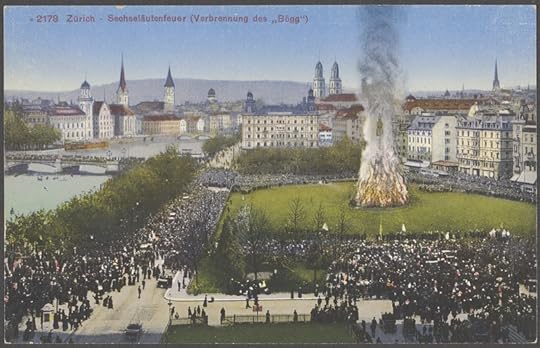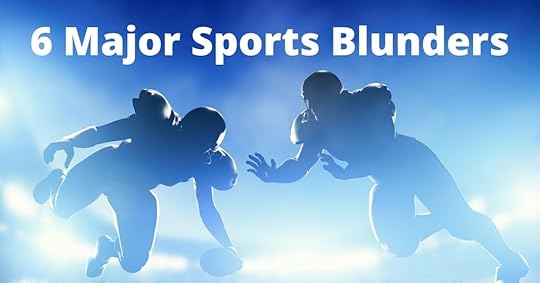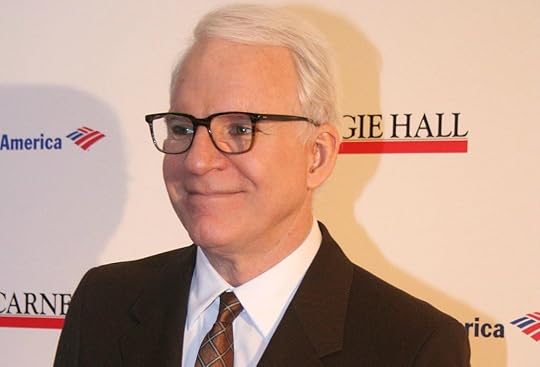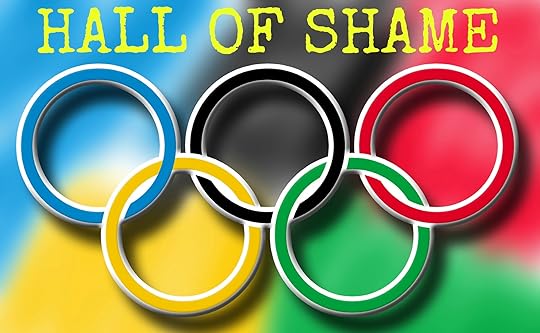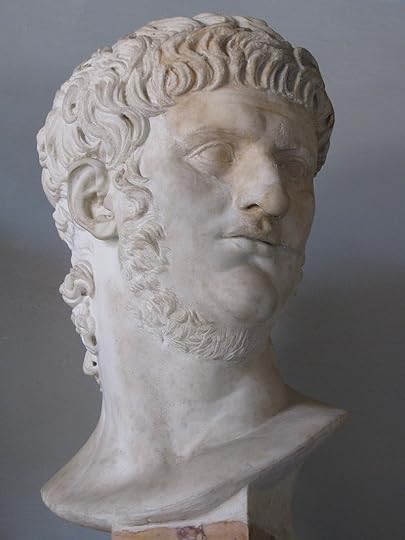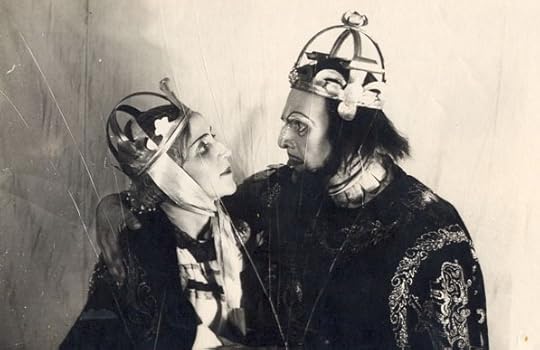Bathroom Readers' Institute's Blog, page 86
April 22, 2016
If the Snowman Explodes, It Must Be Spring
Who needs a groundhog or looking outside to see the sunshine and flowers? In Switzerland, they know it’s Spring when the snowman explodes.
Since the 16th century, the city of Zurich, Switzerland, was welcomed Spring with Sechselauten, a festival whose name means “the six o’clock ringing of the bells.” The seasonal shift was noticed by local craftsmen, who in the winter would work until 5 p.m., when the sun set. As the warmer months approached, the workday was extended to 6 p.m. To herald the arrival of Spring, the largest church bells in the town square would ring at 6 p.m., and then a multi-day celebration would commence.
That tradition continued until 1902, when it got a lot more exciting with the introduction of the Boogg. It’s an 11-foot-tall snowman, and locals stuff it with straw, cotton…and 140 sticks of dynamite. And then they blow it up.
This year’s Sechselauten took place on April 18. While it’s still cold enough in Zurich for there to be enough snow on the ground to craft an 11-foot-tall snowman, the folk wisdom is that the sooner the Boogg’s head blows up, the closer it is to Spring. (It’s sort of like how whether or not the Groundhog sees his shadow determines more Winter or an early Spring.)
One of the main parts of the destruction of the Boogg is placing on bets on how long it will take for the snowman to completely burn to the ground. Last year set an all-time record for slowest burn: 20 minutes and 39 seconds (although the fire did also have to burn down the snowman’s 32-foot-tall wooden funeral pyre.) That meant more Winter for Zurich. The earliest of early Springs was predicted by the Boogg in 2003: That year it took just under six minutes to waste the physical manifestation of Old Man Winter.
And then, once the fire burns down, locals grill meats and sausages on the burning embers.
The post If the Snowman Explodes, It Must Be Spring appeared first on Trivia Books and Facts | Uncle John's Bathroom Reader.
April 21, 2016
Basketball Team Name Origins
Here’s what we dug up about pro basketball team names and their origins.
Los Angeles Lakers
There are no lakes in L.A. The team was originally the Minneapolis Lakers; Minnesota is the “Land of 10,000 Lakes.”
Seattle SuperSonics
Named after a supersonic jet proposed by Seattle-based Boeing in the late ’60s. (The jet was never built, and as of 2008, the team is slated to move to Oklahoma City.)
Detroit Pistons
It’s not named for that city’s auto industry. The team’s founder, Fred Zollner, owned a piston factory in Fort Wayne, Indiana. In 1957 the Zollner Pistons moved to Detroit.
New Jersey Nets
Originally called the New York Nets to rhyme with N.Y. Mets (baseball) and N.Y. Jets (football).
Houston Rockets
They began as the San Diego Rockets—a name inspired by the theme of a “city in motion” and its “space age industries.”
Orlando Magic
Inspired by Disney’s Magic Kingdom.
New York Knicks
Short for knickerbockers, the pants that Dutch settlers in New York wore in the 1600s.
Indiana Pacers
Owners wanted to “set the pace” in the NBA.
Los Angeles Clippers
Started out in San Diego, where great sailing boats known as clipper ships used to land 100 years ago.
Sacramento Kings
When the Cincinnati Royals moved to the Kansas City–Omaha area in 1972, they realized both cities already had a Royals baseball team. They became the K.C. Kings, then the Sacramento Kings.
Atlanta Hawks
Started in 1948 as the Tri-Cities Blackhawks (Moline and Rock Island, Illinois, and Davenport, Iowa), they were named after Sauk Indian chief Black Hawk, who fought settlers of the area in the 1831 Black Hawk Wars. In 1951 the team moved to Milwaukee and shortened the name to Hawks.
The post appeared first on Trivia Books and Facts | Uncle John's Bathroom Reader.
April 17, 2016
The Who? Origins of Band Names
Ever wonder how rock bands get their names? So do we. After some digging around, we found these origins.
CHICAGO
They originally called themselves Chicago Transit Authority, but had to shorten it after the city of Chicago sued.
ALICE COOPER
Lead singer Vincent Furnier claims to have gotten his stage name from a Ouija board, through which he met a spirit with that name.
EURYTHMICS
An 1890s system of music instruction that emphasized physical response.
METALLICA
Drummer Lars Ulrich was helping a friend name a heavy metal magazine. Ulrich’s two suggestions: 1) Metal Mania (which the friend used), and 2) Metallica.
THE REPLACEMENTS
They were filling in for another band at the last minute. When the MC asked who the band was, singer Paul Westerberg replied, “The replacements.”
WHITE STRIPES
While the band members are named Jack and Meg White, the band is named for Meg’s love of red-and-whitestriped peppermint candies.
WEEZER
Lead singer Rivers Cuomo got this nickname in grade school. He had asthma.
THE SMITHS
They wanted a generic name that wouldn’t suggest anything about the band’s kind of music.
XTC
Singer Andy Partridge saw an old movie in which Jimmy Durante said, “That’s it, I’m in ecstasy!”
BLACK SABBATH
From a 1963 Boris Karloff horror movie.
DEF LEPPARD
Singer Joe Elliot once drew a picture of a leopard with no ears—a “deaf leopard.”
MOODY BLUES
They named the band in honor of one of their favorite songs—Duke Ellington’s “Mood Indigo.”
BADFINGER
They were originally called the Iveys. When they signed with the Beatles’ Apple Records label, Paul McCartney gave them this name. It was the original title of the Beatles song “A Little Help from My Friends.”
FALL OUT BOY
In their early years, they asked an audience what their name should be. Somebody yelled “Fall Out Boy.” They liked it and took it, unaware that it was the name of a character on The Simpsons. When they found out, they feared they’d be sued. But The Simpsons’ producers thought the band had the name first, and that they were going to be sued. (Neither was.)
DEATH CAB FOR CUTIE
Named after a song written by Monty Python collaborator Neil Innes for his 1960s psychedelic group, the Bonzo Dog Doo-Dah Band.
TLC
It’s not what you think. It comes from the first letters of each of the group’s first names: Tionne, Lisa, and Chilli.
EMINEM
The rapper gave himself this stage name using his initials— M and M (for Marshall Mathers)—spelled out phonetically.
NINE INCH NAILS
Nine-inch nails are used in coffins. Singer Trent Reznor made a list of potential band names and settled on this one because “it still sounded good after two weeks” and could be easily abbreviated.
WINGS
Paul McCartney came up with it while waiting in a hospital wing as his wife Linda was giving birth to one of their children.
EVERCLEAR
Named after an extremely strong (190 proof) grain alcohol.
COLDPLAY
They stole it from another band that broke up. The original band got the name from a book by poet Philip Horky, entitled Child’s Reflections, Cold Play.
The post appeared first on Trivia Books and Facts | Uncle John's Bathroom Reader.
April 15, 2016
3 Cases of Musical Copyright Infringement
There are only so many notes, so occasionally one hit song sounds a lot like another hit song.
In 1982, the Australian rock band Men at Work hit #1 in the U.S. with “Down Under” a song about a proud Australian man traveling the world. It’s also notable for being one of few major hit songs to feature a flute solo. It wasn’t until 2008—more than 25 years after the song’s release—that its writers (Men at Work’s Colin Hay and Ron Strykert) were sued for copyright infringement. After an Australian game show fielded the question “what children’s song is contained in ‘Down Under’?” Larrikin Music received hundreds of emails and phone calls pointing out that indeed, the 1932 song “Kookaburra,” of which the company owned the rights, sounded a lot like the flute solo in “Down Under.” A judge ruled that copyright infringement had occurred, and that going forward 5 percent of royalties for “Down Under” would go to Larrikin. Shortly thereafter, Hay re-recorded the song…changing the melody of the flute solo.
In April 2016, a judge ruled that a jury would hear the case of if Led Zeppelin stole the riff of “Stairway to Heaven”—perhaps the most famous riff of the most famous rock song in history. Two years ago, the estate of the deceased Randy Wolfe sued Led Zeppelin’s Robert Plant and Jimmy Page for appropriating the opening melody from “Taurus,” an instrumental song released by Wolfe’s band Spirit in 1968. Never heard of Spirit? They’re pretty obscure, although the suit alleges that Page and Plant could have heard the song because their band shared a bill with Spirit at three music festivals after “Taurus” was released.
In 1994, British rock band Oasis had a hit with “Shakermaker.” It reminded a lot of people of 1971 the Coca-Cola jingle-turned-actual song “I’d Like to Teach the World to Sing.” Among those who noticed a resemblance: the New Seekers, the folk band who actually wrote the song. They sued Oasis for copyright infringement and the parties agreed on a $500,000 settlement. Ever since, Oasis singer Liam Gallagher jokingly inserts lines from “I’d Like to Teach the World to Sing” when he performs “Shakermaker” live.
The post 3 Cases of Musical Copyright Infringement appeared first on Trivia Books and Facts | Uncle John's Bathroom Reader.
Blow it Like Buckner: 6 Major Sports Blunders
The 1986 Boston Red Sox were one out away from winning the World Series …until a ball rolled through first baseman Bill Buckner’s legs. The NY Mets won the game, forcing a decisive game 7, which they also won. Buckner became a sports pariah, but he’s not the only athlete ever to screw up.
Nice Going, Spike
In one of his first NFL games in 2008, Philadelphia Eagles wide receiver DeSean Jackson caught a long pass from quarterback Donovan McNabb. Running it in for his first pro touchdown, Jackson spiked the ball and started celebrating. Then the other team, the Dallas Cowboys, called foul: A videotape review showed that Jackson had thrown the ball down on the oneyard line, before he crossed into the end zone. Result: The touchdown was taken away. Amazingly, Jackson had lost a touchdown the same way in a high-school football game six years earlier.
No Time For You
In the 1993 men’s college basketball national title game, Michigan trailed North Carolina by just two points, 73–71, with less than 30 seconds to go. After North Carolina missed a free throw, Michigan’s Chris Webber got the rebound and hustled the ball down to the other end of the court. With 20 seconds left, Webber called a time-out to reset the play. Except that Michigan didn’t have any time-outs left. For the mistake, Webber was issued a technical foul, which gave North Carolina a couple more free throws, securing them the win.
A Very Big Oops
Colombia was one of the pre-tournament favorites to win soccer’s 1994 World Cup. But in the opening rounds, the team surprisingly lost to the United States 2–1, with the second goal for the U.S. coming when star Colombian defender Andres Escobar accidentally scored a goal on his own net. Colombia was eliminated from the tournament. (Sad ending: When the 27-year-old athlete returned home to Medellin, Colombia, he was murdered, reportedly by someone related to angry members of a gambling syndicate.)
Lettdown
Just minutes into the 1993 Super Bowl, the Buffalo Bills fumbled the ball on their own 45-yard line, where it was recovered by Dallas Cowboys lineman Leon Lett. He then did what few linemen ever do: He ran it all the way to the other end for a touchdown. As he was about to cross the goal line, he slowed down to celebrate the moment, raising the ball in triumph…and it was knocked out of his hands by Bills receiver Don Beebe. Lett had no idea Beebe was on his tail. Instead of Dallas getting a touchdown, the Bills got the ball (although the Cowboys won the game anyway).
Error Prone
Tommy John pitched for more than 20 years and won 200 games, but he’s best known for two things: 1) for being one of the first to undergo arm-strengthening elbow surgery (“Tommy John surgery,” as it’s now known) and 2) for making three errors in a single play. John was on the mound for the Yankees in 1988 when Milwaukee’s Jeffrey Leonard hit an easy ground ball to him. John bobbled it (error #1), and Leonard made it to first base. John threw the ball to first base anyway, but the throw was wild and wound up in right field (error #2). The right fielder then threw it back to the catcher in an attempt to tag a runner at home plate. John intercepted it and threw it to the catcher himself—again, his throw was wild (error #3, which tied the Major League record).
Friend or Foe
The 1982 men’s college basketball championship game was a fight to the finish, with 15 lead changes and neither Georgetown nor North Carolina ever ahead by more than three points.
Georgetown was leading 62–61 with under a minute left to play, when North Carolina freshman Michael Jordan hit a jump shot to make the score 63–62. Georgetown’s Fred Brown quickly rebounded the ball and ran to the other end, where he confidently passed it to an open player, James Worthy. Only problem: Worthy played for North Carolina. Georgetown quickly fouled Worthy to stop the clock. He missed both foul shots, but it didn’t matter—there wasn’t enough time left for Georgetown to score, so North Carolina won the game.
The post Blow it Like Buckner: 6 Major Sports Blunders appeared first on Trivia Books and Facts | Uncle John's Bathroom Reader.
April 14, 2016
How They Did in Their Final Game
This week, NBA star Kobe Bryant closed out his 20-year career by scoring 60 points in his final game. Here’s how some other basketball stars fared their last time on the court.
In 1991, Magic Johnson’s career was abruptly cut short when he announced that he was HIV positive. He didn’t play that season, but was still voted to the 1992 NBA All-Star Game. Johnson was the game’s Most Valuable player, scoring 25 points and a last-second three-pointer. After an absence of nearly four years, Johnson returned to the court for the Los Angeles Lakers in early 1996. He averaged 14.6 points in 32 games. His final game: Game 4 of a first-round playoff series. In a series-ending loss to the Houston Rockets, Johnson played 30 minutes off the bench and scored 8 points.
After 13 seasons and three NBA championships, Johnson’s friend and rival Larry Bird of the Boston Celtics announced he would retire at the end of 1992 season. (He’d missed large chunks of the last four seasons due to injuries.) After sweeping the Indiana Pacers in the first round of the playoffs, the Celtics took the Cleveland Cavaliers to a full seven games of their Eastern Conference semifinal. Cleveland beat Bird and the Celtics 122 to 104. Bird scored just 12 points.
David Robinson played his entire career with the San Antonio Spurs, the team that drafted him with the #1 pick in 1987. (Although he didn’t begin play for two more years, because he had to fulfill military service requirements.) He led the team to championships in 1999 and 2003. And that was how Robinson went out: the decisive game 6 of the 2003 NBA Finals.
After winning three championships for the Chicago Bulls, Michael Jordan retired from the NBA in 1993 (to play baseball), returned two years later, and won three more titles. After that he retired, and could’ve walked away from the court with his last game a Finals-clinching win. But he came back again in 2001, this time for the Washington Wizards. After two middling seasons, he retired for good in April 2003. In his last game, against the Philadelphia 76ers, Jordan scored 15 points. His final shots: two humble free throws.
The post How They Did in Their Final Game appeared first on Trivia Books and Facts | Uncle John's Bathroom Reader.
Why Do Americans Pay Their Taxes on April 15?
Because if we didn’t we’d go to jail. Okay, but there are other reasons why taxes are due by that particular date.
The United States was founded after declared independence from the United Kingdom, an action in part due to “taxation without representation.” Not being taxed was an American concept that lasted for a good 140 years…until Congress passed the 16th Amendment in 1913, establishing an income tax. At the time, the rates ranged from 1 percent (for those who earned under $3,000) all the way up to 6 percent for those with the highest incomes. In early 1914, Congress declared that March 1, 1914 would be the first tax day—the date upon which taxes for the previous calendar year were due to the Internal Revenue Service. That date was chosen because it was about a year after the ratification of the 16th Amendment.
The IRS quickly realized that it was a tremendous amount of work to process the tax returns of every American adult (or at least those who had paid), so in 1918 it moved Tax Day back two weeks to March 15 to give itself more time. The current tax deadline of April 15 was established in 1955, again for more time. Then again, time is money. By having a filing date that late into the year, the federal government is able to earn interest by holding onto previously withheld payroll taxes before issuing refunds.
It’s not always on April 15, however. If that date falls on a weekend, it’s moved up to the following Monday. This year, Tax Day is April 18, because April 15 falls on a Friday. In Washington, D.C., that day is a holiday: Emancipation Day, commemorating the 1862 abolishment of slavery in the district. Residents of Maine and Massachusetts get to wait until April 19, because April 18 is Patriot’s Day, recognizing the Revolutionary War battles of Lexington and Concord.
The post Why Do Americans Pay Their Taxes on April 15? appeared first on Trivia Books and Facts | Uncle John's Bathroom Reader.
April 11, 2016
3 Celebrities Who Give Way More Than an Autograph
Before the days of instant interaction via the Internet and social media, the way to tell a celebrity you liked their work was to write them a fan letter. In return, you might get a signed headshot and a form letter. Here are some celebrities, from then and now, with creative responses to fans.
Steve Martin
In the 1980s, Steve Martin sent out a response letter that was both a form reply and a mockery of form replies. An excerpt: “Too often performers lose contact with their audience and begin to take them for granted, but I don’t think that will ever happen to me, will it ________?” (In the blank went the writer’s name.) Martin’s letters also included a fill-in-the-blank postscript: “I’ll always cherish that afternoon we spent together in Rio, walking along the beach, looking at _______.”
Jonah Hill
Jonah Hill, star of Superbad and The Wolf of Wall Street, thinks signing autographs is a little bland and impersonal. Instead, when he’s approached by a fan he hands out a business card that reads “I just met Jonah Hill. It was a total letdown.”
John Cleese
Around the time when he starred on Fawlty Towers in the 1970s, John Cleese sent out a stock fan letter to fans, but it was a pretty good one. It read:
I am afraid I’m much too important to write notes to people like you. Please remember that I am very very very very very very important. I enclose a photograph to remind you of my importance.
The post 3 Celebrities Who Give Way More Than an Autograph appeared first on Trivia Books and Facts | Uncle John's Bathroom Reader.
Olympic Cheaters
Some people become famous at the Olympic games because they win a medal. Others become infamous because they don’t play by the rules. Here’s a look at the BRI’s Olympic Hall of Shame.
ROMAN EMPEROR NERO
Place: Olympia
What happened: Nero decided to compete in the chariot race. In the middle of the event, however, he fell off his chariot and was left behind in the dirt. He never completed the course.
Reaction: The Olympic judges, “under extreme pressure,” declared him the winner anyway.
SPYRIDON BELOKAS (Greek marathon runner)
Year: 1896
Place: Athens, Greece (the first modern-day Olympics)
What happened: These Olympics were a matter of national pride for Greeks. So Belokas became a national hero when he won the bronze medal. But shortly after the games ended, he admitted to “hitching a ride in a horse-drawn carriage” during the race.
Reaction: He was stripped of his medal and running shirt, and became a national disgrace overnight.
JOHN CARPENTER, (American runner, 400-meter finals)
Year: 1908
Place: London
What happened: Scottish champ Wyndham Halswelle, the fastest qualifier and the person favored to win, was rounding the final turn neck-and-neck with three U.S. runners when one of them— Carpenter—shoved him sideways. John Taylor, another of the Americans, “won” the race, but not before a British official broke the tape and declared “no race.”
Reaction: Carpenter was disqualified; Halswelle and the other two American finalists were invited to re-run the race two days later, “this time in lanes separated by strings.” The Americans refused. Halswelle re-ran the race alone and won the gold medal automatically, the only person ever to win the gold in a “walkover.”
MEMBERS OF THE EAST GERMAN LUGE TEAM
Year: 1968
Place: Grenoble, France (Winter Games)
What happened: The East Germans placed first, second, and fourth in the luge competition. Then Olympic officials discovered that they’d “used a chemical to heat the runners of their toboggans to increase speed.”
Reaction: They were disqualified and forfeited their medals. But the East German team never admitted guilt, blaming the incident on a “capitalist plot.”
FRENCH OLYMPIC AUTHORITIES AND THE FINNISH OLYMPIC COMMITTEE
Year: 1924
Place: Paris
What happened: Finland’s Paavo Nurmi was the world champion long-distance runner. But for some reason, French officials didn’t want Nurmi to sweep the gold medals in the 1,500, 5,000, and 10,000-meter events. So they scheduled the 5,000-meter final just 55 minutes after the 1,500-meter final, hoping Nurmi would be too tired to win the second race. Then Finnish officials arbitrarily dropped Nurmi from the 10,000-meter race so Ville Ritola, Finland’s second-best runner, would have a shot at a gold medal.
Reaction: Nurmi was furious, but there was nothing he could do about it. He ran the 1,500-meter event…and won in record time. Then, less than an hour later, he ran the 5,000 meter…and won that in record time. Finally, according to legend, “as Ritola won the 10,000 meters by half a lap in world record time, Nurmi ran a lone 10,000 meters outside the stadium and beat Ritola’s time.”
The post Olympic Cheaters appeared first on Trivia Books and Facts | Uncle John's Bathroom Reader.
April 8, 2016
The Curse of the Scottish Play
It’s the most famous curse in theatrical history: Shakespeare’s Macbeth is cursed. Theater people just call it “The Scottish Play” in an attempt to avoid that curse. Here are some examples of when the Macbeth curse proved horribly true—if those involved can be believed.
Macbeth was first presented in London in August 1606. The actor playing Lady Macbeth (Shakespeare’s company used only male actors) died that night, after the performance. (This one probably isn’t true—theatrical records from the era are spotty, so the name of the actor isn’t even known, or if Macbeth’s debut was even in August 1606.)
President Abraham Lincoln was an active theatergoer up until the day he died—when he was shot in a theater during a viewing of a comedy called Our American Cousin. Eyewitnesses from 1865 report that the night before his assassination, Lincoln had read Macbeth.
Sir Laurence Olivier starred in a lavish production at London’s Old Vic Theatre in 1937. While speaking his lines on stage, a weight fell from the rafters and hit the ground, missing Olivier by about a foot. But the show must go on, and it did…although during another performance one of the swords used during a fight scene—a real sword—flew into the audience and hit a patron. It didn’t kill him, but it did make him suffer a heart attack
Before a 1942 production starring John Gielgud debuted, three of the show’s actors died. On the day the show was set to open, the set designer committed suicide.
Charlton Heston starred in a 1953 version. He somehow avoided death in a motorcycle crash while rehearsals were underway. But he made a full recovery and took the stage, only to have his legs mysteriously catch fire. It was later discovered his tights had been soaked in kerosene by an unknown culprit.
British actress Diana Wynyard portrayed Lady Macbeth in a 1948 production. During rehearsals, she told a reporter that she thought the play’s curse was silly. While performing in a sleepwalking scene the next day, Wynyard fell into the orchestra pit.
The post The Curse of the Scottish Play appeared first on Trivia Books and Facts | Uncle John's Bathroom Reader.

